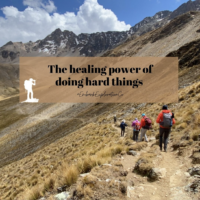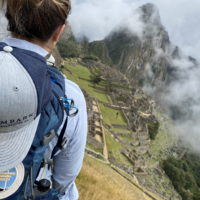All roads lead to Machu Picchu”
10 things to know about trekking to Machu Picchu
01.25.2021

Thinking about trekking in the Andes and Machu Picchu and ticking a huge adventure off your bucket list? That’s a great idea!
We love Peru here at Embark and have been running trips to and around the Machu Picchu area for years. So, we consider ourselves experts on Machu Picchu treks.
With that in mind, here are 10 things you need to know before trekking to Machu Picchu. Let’s dive in and find out more.
While the Inca Trail is definitely the most famous trail that brings you to Machu Picchu, it’s not your only option- far from it! There are a plethora of genuine Incan trails that follow the most jaw- dropping routes leading to this world- famous Peruvian landmark.
Depending on how much time you have to trek, your fitness and experience level, and what you want specifically out of your Peruvian trekking adventure, these numerous routes can be tailored specifically for you.
1. Acclimatization Is A Must
Make sure you plan for an extra couple of days before your trek to acclimatize in the capital of Cusco. At over 11,000 feet, this picturesque city – and gateway to Machu Picchu – will take a few days to adjust.
Most treks start at or above the 11,000ft mark, so by taking the elevation seriously, resting, hydrating and taking time to adjust to the elevation, you will be setting yourself up for success!
2. Our curated, quieter trails encounter more Incan sites and indigenous communities
Away from the hustle and bustle of the Inca Trail, you can explore alternate Machu Picchu routes that tend to have fewer tourists (or none at all!) and have more local history and culture to soak up. Different Machu Picchu treks – like our Hidden Valleys or Ausangate treks- take you through villages home to indigenous communities, exposing you to a more authentic Peruvian experience.
Along the way, you’ll also be able to see hidden Inca sites more intimately, without coming in contact with other hikers. Sounds pretty great to us!
3. The Sun Gate trail is not exclusive to the Inca Trail
The iconic view of Machu Picchu appearing through the morning mist can be found at the Sun Gate entrance to the park. This traditional way of entering Machu Picchu is profound and is a lasting memory for our Machu Picchu trekkers – it is the view that everyone wants to see. But you don’t have to take on the Inca Trail to access the Sun Gate. In fact, the Sun Gate trail is available on a whole host of other Machu Picchu treks Plus- it’s a great adventure: you board the train to Machu Picchu but disembark halfway there, parting ways from other tourists, to begin your climb up the valley; passing other ruins the hordes on Machu Picchu never see, entering above Machu Picchu. Knowing how awesome this adventure is, we’ve fashioned most of our treks to easily link up with the Sun Gate Trail towards the end of your multi- day hike, so that you can enter the UNESCO World Heritage site from this iconic point.
4. Many longer treks can be combined to bring you to Machu Picchu
Honestly, there are so many amazing multi-day treks in Peru, that doing just one adventure doesn’t really seem like enough! You can easily combine your Machu Picchu hikes with longer treks to Rainbow Mountain trek or further into the mighty Peruvian Andes.
In the Machu Picchu area, the trail network is pretty substantial, so there are always ways to link up a couple of amazing multi-day hikes to create one awesome, once-in-a- lifetime adventure!
5. There are actually two great mountains inside the park!
So, of course, Machu Picchu Mountain is undoubtedly the most famous mountain and trail in Peru, and arguably, in the whole of South America. That being said, there is another Inca icon in the same park – Huayna Picchu.
The distinctive, pointed massif that looms over and above the Machu Picchu is the lesser-known of the two. Huayna Picchu is easily accessible from Machu Picchu and takes around two hours to climb up from the iconic Lost City of the Incas. Once at the top of Huayna Picchu, you’ll be rewarded with stunning views of the Inca site.
With an almost bird’s eye view looking down on the site, historians and archeologists theorize that this area was used to scout for possible intruders.
Nowadays, it serves as a mental and physical challenge to those brave enough to scale is many steep obstacles. Indeed you will gain a massive appreciation for the industriousness, ingenuity of the Incan people in carving out this spot.
Directly across the way and on the opposite end of Machu Picchu is Machu Picchu mountain. Less steep but still a great adventure, it is another 3 hour hike inside of Machu Picchu park that is well worth it.
6. June and July are two of best months to visit Machu Picchu
Two of the driest months of the year, combined with a milieu of culturally-significant festivals make these the best months to visit Peru. Indigenous culture revolves around the solstice, so there is a vibrant buildup to the winter solstice at the end of June, but many activities continue into most of July as well.
Entering Cusco any day in June, you will witness everything from a competition of local dances, Andean Corpus Christi, and some of the largest parades packing Cusco’s central square that you’ve ever encountered. This makes it the perfect time to book your Machu Picchu trek!
7. The Inca Trail has its pros and cons
As the most popular route to Machu Picchu, many people journey across this trail each and every year, and it’s not without reason. The trail does have stunning views and is well-established with an infrastructure of porters, established camps and a host of rules and regulations to help protect the route. Due to its notoriety, and with plenty of tour operators to choose from, the trail is busy and can be particularly crowded at times. If you’re looking for a tranquil and peaceful trekking experience, the Inca Trail isn’t going to scratch that itch, and you might want to think about choosing one of our carefully chosen alternate routes. If you do decide that the Inca Trail is for you, it’s best to do it in 5 days.
The second to the last campsite, called Phuyupatamarca, boasts some of the most amazing views, with a magical sunrise and sunset.
8. The Inca Trail definitely gets crowded!
Each day in the peak season, you’ll find around 500 people hiking along the Inca Trail. This is made up of around 200 tourists and 300 workers. These workers are made up of guides, porters, and cooks.
So, in fact, the vast majority of people on the mountain trail are actually the people who make the Machu Picchu industry tick over safely!
9. Peak physical conditioning is optimal for any trek in Peru
Most treks in Peru are high altitude and require hiking for four to eight days crossing a series of high passes. Come prepared to hike 5 to 7 hours each day, for multiple days in a row. Trekking in Peru is definitely physically demanding, and the more you train for your trek, the more you’re going to enjoy your adventure!
10. There’s so much more to experience beyond Machu Picchu
Adventure is definitely a “thing” in Peru so if you arrive thinking you’re “JUST” going to visit Machu Picchu but then get inspired and want to tack on a visit to a local village, do some mountain biking, rafting or rock climbing you can do it all! Visit the Amazon, explore the Paracas Islands or stare in wonderment at the Nazca Lines from a private plane.
So, there you have it, our top 10 things that you should know before trekking to Machu Picchu. We run a whole host of different treks, routes, and tours around Machu Picchu, so don’t hesitate to get in touch for more information!



